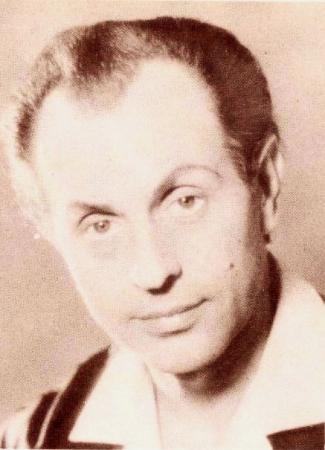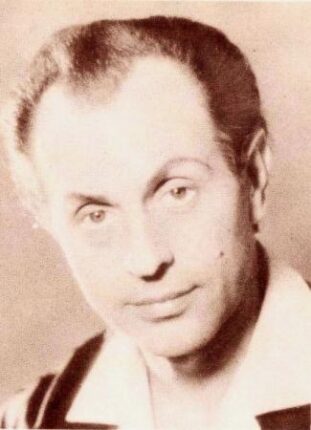Witold Borkowski – dancer, choreographer, director, teacher. He was born on 26 October 1919 in Vilnius; he died on 5 November 1995 in Warsaw. In 1937 he completed the Ballet Studio of Murashova in Vilnius and he made his debut at Lutnia Theatre in Vilnius, in the ballet “Invitation to the Dance” by Weber. In the season 1937/1938 he performed with Feliks Parnell Polish Ballet, and in the season 1938/1939 with Wielka Rewia Theatre in Warsaw. When the Second World War started he went back to Vilnius and in 1939–1941 he worked as a dancer and assistant choreographer of Lutnia Music Theatre. In 1941 he got to Warsaw and in 1944 he took part in performances of official theatres: Maska Theatre and Variety Theatre “Jar”. In 1945 he moved to Cracow where he danced in duo with Olga Glinkówna in the group Gospoda Aktorów of Juliusz Słowacki Theatre, until 1947 he was a member of Parnell Ballet with whom he performed throughout Poland. In 1947–1949 – a principal, teacher and assistant to the ballet master of Silesian Opera in Bytom. In 1950 he became a principal dancer of the Warsaw Opera’s ballet (to 1964). He staged “Symphonie fantastique” by Berlioz, “Boléro” by Ravel, he created the choreography for “Les contes d’Hoffmann” by Offenbach, “Don Giovanni” by Mozart. He travelled to Helsinki, Monte Carlo, Toulouse and Paris with the Warsaw Opera’s ballet. In 1955–1959 he studied choreography at the National Higher Theatre School in Warsaw, he also participated in trainings and scholarships in Leningrad, Moscow (GITIS), London and Paris. In the season 1964/65 he became the ballet director and chief choreographer of the Łódź Opera and he held the position until the end of the season 1974/1975. He was the artistic director of the Lodz Opera’s ballet studio (1967–1972), the founder of the Lodz International Ballet Festival (1968). In Łódź he staged many standard ballets. In 1975–1980 he was the ballet director and choreographer of the Central Artistic Group of Polish Army (CZA WP) in Warsaw. Since the early 50’s he co-operated in the field of choreography with many music and drama theatres. He was a member or the president of different Polish and foreign competitions’ juries, among others in Warsaw (1959), w Varna (1970, 1974, 1986), in Peru (1985), in Japan (1987, 1911); a member of the Executive Committee of the Board and the president of the choreography department of the Polish Actors Association (ZASP) and the Polish Association of Writers and Composers ZAiKS.
The most important parts:
The Devil and Pan Twardowski (Pan Twardowski), Piękny chłopiec (Swantewit), Satyr (Walpurgisnacht), Franz (Coppelia), Till (Till Eulenspiegel), Siegfried (Swan Lake), Romeo (Romeo and Juliet), Jan Kazimierz (Mazepa), Petruschka (Petruschka), Faun (Afternoon of a Faun), Bachus (Zaczarowana oberża), Gypsy (The tale of stone flower)
The most important choreographies:
The Sleeping Beauty (Łódź), Don Quixote (Wrocław) and Don Quixote by Minkus in London with Ballet Rambert (1962), with London Festival Ballet (1970, 1975), Don Quixote and Romeo and Juliet in Oslo (1969), The Sleeping Beauty in Vilnius (1972), Brno (1974), Skopje (1989), Master Twardowski in Havana (1974), premiere of Pope Joan by Stoyanov in Sofia (1970), The Fountain of Bakhchisarai by Asafiev in Skopje (1981), Romeo and Juliet in w São Paulo (1985).
The most important choreographies in drama and music theatres:
The Wind Of Liberty by Dunayevsky, A Midsummer Night’s Dream by Shakespeare, Unsettled Hapiness by Milyutin, Bal z Fanfare by Gaczek, The Vagabound King by Frimml, The Four Curmudgeons by Goldoni , Mazepa by Słowacki, Masquerade by Lermontov, Parady by Potocki, Aida, Traviata and Rigoletto by Verdi, Stańczyk by Kisewetter, Carmen by Bizet, Ball at the Savoy by Abraham, L’adorabile Giulio by Kramer, Joan d’Arc by Piejko and Chess-Mate by Bliss, The Countess by Moniuszko, Orpheus in the Underworld by Offenbach, The marriage market by Jacobi, Der Vogelhandler by Zeller.

